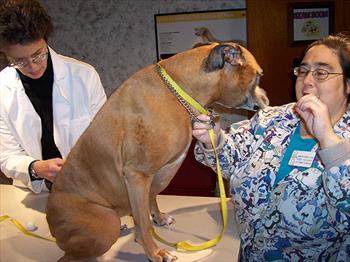As the current Executive Director of Dr. Sophia Yin’s (1966 – 2014) company, CattleDog Publishing, I am quickly realizing that I have some pretty incredible shoes to fill. Two of the many things that Dr. Yin was known for, before her passing, was her passion for research and her love for writing in a way that anyone could understand and follow. The fun part of my position with CattleDog Publishing, in addition to being a full-time practicing veterinarian, is the challenge of keeping up with the schedule, style, and depth of content that she was known for in her writing. In my writing of this blog in preparation for Veterinary Technician Week (October 16–22, 2016), I reflected on the lessons I learned during my years as a veterinarian, and over the last year of working at Dr. Yin’s legacy company, and I have come to the realization that there is no such thing as a leader without wonderful and talented individuals who you can dance with in the partnership of animal care and behavior training.
Shall we Dance?
I always liked the video with the swing-dancing partners on our website. I immediately understood the comparison she made between dog training and partner dancing. My husband and I enjoy social ballroom dancing and I know first hand how there is a partnership of both the lead knowing what to do and clearly communicating that through body language, and as a follower knowing my part to follow. It is active following, not passive, and it rests on both the lead and follower being aware of both roles to dance together enjoyably.
As a veterinarian in practice I have always been thoughtful of working together with technicians and handlers. Even before I learned less stressful handling techniques and created a more animal friendly clinic environment, I was always aware of what my technician needed to do to hold an animal, what equipment to gather for a procedure, and I tried not to interfere with them delivering care. The Low Stress Handling™ Certification program solidified this knowledge of communicating with the technician about what tests, exams, or procedures I needed to do before jumping into it. A plan for handling based on reducing stress and pain was determined by both of us, with either the technician or myself leading the process. If the animal struggled or became stressed, there was a clear way that the tech or myself would indicate it was time to stop and adjust our approach. No pushing through, and no toughing it out to get the job done.
Who Leads? Who Follows?
As my staff and I worked in a more partnered way, my appreciation for their skills in observing the animal’s behavior, health, and history taking increased. I have always appreciated their loyalty, dedication, medical training, and skills. Somehow, this partnering in handling opened my eyes to the value of the technician to the veterinarian. Providing good care to animals is not only about sample collection, accurate history taking, or surgical assisting, it is also about understanding the need for all of that in partnership with communicating with the veterinarian and the patient during care. There is no hierarchy and at times my technician will tell me how to approach an animal to reduce stress – and I listen! At other times, I will tell the technician how we should approach an animal due to suspected pain from a medical problem – and they listen!
Working in partnership during exams and care is a bit difficult at first. Veterinarians are not trained to do this in school. As a veterinarian you are focused on diagnostic tests, preventative care, surgery, and client education. When you learn about animal behavior in care, you see the need to partner with your staff because that leads to the best care. Similar to initially learning the first steps in partner dancing, doctor/technician partnering can be difficult – you step on a few toes (literally at times!) – as the hierarchy is leveled. By stopping and reviewing each other’s role and steps, the partnering improves. When veterinarians don’t follow the technician’s lead, then there is a struggle.
I thank all of the technicians who have taken the lead with their veterinarians in animal handling and care. I know it is a step out of your usual role, and I applaud you for taking it. Our profession is finally changing to embrace the patient’s physical and behavioral needs, in addition to knowing when to follow the lead of our technicians and handlers.
Dr. Foote Demonstrates:
For More Information:
- American Veterinary Medical Association – National Veterinary Technician Week (October 16–22, 2016)
- National Association of Veterinary Technicians in America – National Veterinary Technician Week (October 16–22, 2016)





